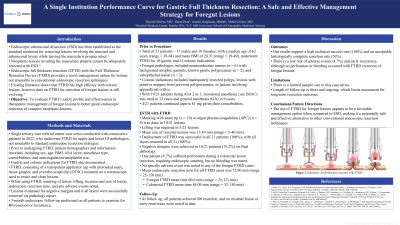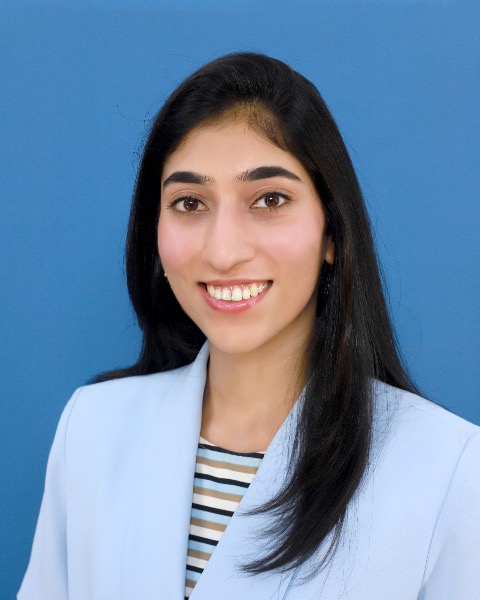Monday Poster Session
Category: Stomach
P2714 - A Single Institution Performance Curve for Gastric Full Thickness Resection: A Safe and Effective Management Strategy for Foregut Lesions
Monday, October 23, 2023
10:30 AM - 4:15 PM PT
Location: Exhibit Hall

Has Audio

Anusha Singhania, MBBS
Swedish Medical Center
Seattle, WA
Presenting Author(s)
Award: Presidential Poster Award
Rajnish Mishra, MD1, Diana Dinh, 1, Anusha Singhania, MBBS1, Mohit Girotra, MD2
1Swedish Medical Center, Seattle, WA; 2Swedish Medical Center, Washington State University Elson S. Floyd School of Medicine, Seattle, WA
Introduction: Full-Thickness Resection Device (FTRD) provides a novel management option for lesions not amenable to conventional endoscopic resection techniques. However, the data on FTRD for resection of foregut lesions is still evolving.
Methods: This is a single tertiary care referral center case series of consecutive patients in 2022, who underwent FTRD for upper and lower GI pathologies, not amenable to standard endoscopic resection strategies.
Results: A total of 21 patients underwent FTRD - 11 males and 10 females, with median age 62 years (range = 38-84) and mean BMI 28.31 (range = 19-49), for 10 gastric and 11 colonic indications.
Foregut pathologies included neuroendocrine tumors (n=6) with background atrophic gastritis, known gastric polyp/cancer (n=2) and subepithelial lesion (n=2). The colonic indications included inadequately resected polyps or positive margins from previous polypectomies or those involving appendiceal orifice. 19/21 patients being ASA 2 or 3, MAC was used in 12, and GA in 9 cases, and 4 patients needed to continue ASA 81 mg for their comorbidities.
Lifting was done in 5/21 lesions, and 19/21 were marked using snare tip (n=10) or APC (n=9). Mean size of the resected lesions was 13.49 mm (range 5-40 mm). Deployment of FTRD was technically successful in all 21 patients (100%), with all layers resected in all 21 (100%), but negative margins achieved in 16/21 (76.2%) on the final pathology. One patient (4.7%) suffered perforation during a colorectal lesion resection, requiring endoscopic suturing, and no bleeding was noted. No specific adverse event was noted in any of the foregut FTRD cases. Mean endoscopic resection time for all FTRD cases was 72.90 min (range 25-150 min): Foregut FTRD mean time 60.6 min (range 25-121 min) and Colorectal FTRD mean time 84.09 min (range = 32-150 min). Although the length of follow-up is short and on-going, but 3-month endoscopic follow-up was performed on all patients in whom R0 resection was achieved, and no residual lesion or early recurrence was noted till date.
Discussion: Our results support a high technical success rate (100%) and an acceptable histologically complete resection rate (76%), with a low risk of AEs (4.7%) and early recurrence for FTRD resection of foregut lesions.
Also, the learning curve of FTRD for foregut lesions appears to be favorable, when compared to endoscopic submucosal dissection (ESD), for management of foregut lesions.
Disclosures:
Rajnish Mishra, MD1, Diana Dinh, 1, Anusha Singhania, MBBS1, Mohit Girotra, MD2. P2714 - A Single Institution Performance Curve for Gastric Full Thickness Resection: A Safe and Effective Management Strategy for Foregut Lesions, ACG 2023 Annual Scientific Meeting Abstracts. Vancouver, BC, Canada: American College of Gastroenterology.
Rajnish Mishra, MD1, Diana Dinh, 1, Anusha Singhania, MBBS1, Mohit Girotra, MD2
1Swedish Medical Center, Seattle, WA; 2Swedish Medical Center, Washington State University Elson S. Floyd School of Medicine, Seattle, WA
Introduction: Full-Thickness Resection Device (FTRD) provides a novel management option for lesions not amenable to conventional endoscopic resection techniques. However, the data on FTRD for resection of foregut lesions is still evolving.
Methods: This is a single tertiary care referral center case series of consecutive patients in 2022, who underwent FTRD for upper and lower GI pathologies, not amenable to standard endoscopic resection strategies.
Results: A total of 21 patients underwent FTRD - 11 males and 10 females, with median age 62 years (range = 38-84) and mean BMI 28.31 (range = 19-49), for 10 gastric and 11 colonic indications.
Foregut pathologies included neuroendocrine tumors (n=6) with background atrophic gastritis, known gastric polyp/cancer (n=2) and subepithelial lesion (n=2). The colonic indications included inadequately resected polyps or positive margins from previous polypectomies or those involving appendiceal orifice. 19/21 patients being ASA 2 or 3, MAC was used in 12, and GA in 9 cases, and 4 patients needed to continue ASA 81 mg for their comorbidities.
Lifting was done in 5/21 lesions, and 19/21 were marked using snare tip (n=10) or APC (n=9). Mean size of the resected lesions was 13.49 mm (range 5-40 mm). Deployment of FTRD was technically successful in all 21 patients (100%), with all layers resected in all 21 (100%), but negative margins achieved in 16/21 (76.2%) on the final pathology. One patient (4.7%) suffered perforation during a colorectal lesion resection, requiring endoscopic suturing, and no bleeding was noted. No specific adverse event was noted in any of the foregut FTRD cases. Mean endoscopic resection time for all FTRD cases was 72.90 min (range 25-150 min): Foregut FTRD mean time 60.6 min (range 25-121 min) and Colorectal FTRD mean time 84.09 min (range = 32-150 min). Although the length of follow-up is short and on-going, but 3-month endoscopic follow-up was performed on all patients in whom R0 resection was achieved, and no residual lesion or early recurrence was noted till date.
Discussion: Our results support a high technical success rate (100%) and an acceptable histologically complete resection rate (76%), with a low risk of AEs (4.7%) and early recurrence for FTRD resection of foregut lesions.
Also, the learning curve of FTRD for foregut lesions appears to be favorable, when compared to endoscopic submucosal dissection (ESD), for management of foregut lesions.
Disclosures:
Rajnish Mishra indicated no relevant financial relationships.
Diana Dinh indicated no relevant financial relationships.
Anusha Singhania indicated no relevant financial relationships.
Mohit Girotra indicated no relevant financial relationships.
Rajnish Mishra, MD1, Diana Dinh, 1, Anusha Singhania, MBBS1, Mohit Girotra, MD2. P2714 - A Single Institution Performance Curve for Gastric Full Thickness Resection: A Safe and Effective Management Strategy for Foregut Lesions, ACG 2023 Annual Scientific Meeting Abstracts. Vancouver, BC, Canada: American College of Gastroenterology.

